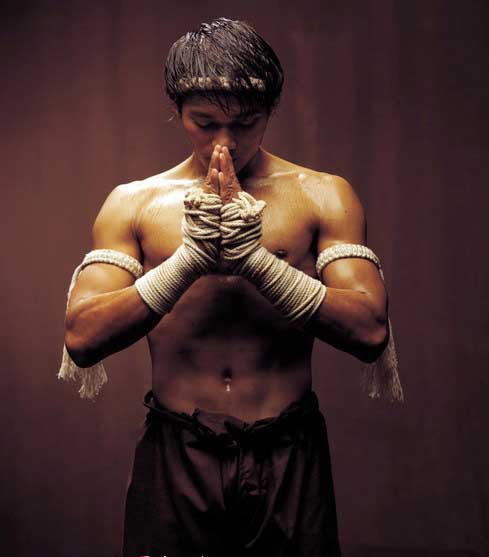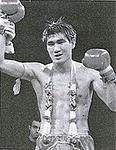The Art of Muay Thai-Somrak Kamsing
 Somrak Kamsing used to be one of the thousands of young Muay Thai fighters from Isan, one of the poorest regions in Thailand. He recalled the times when he witnessed how his family had to work all day just to be able to eat at night. Somrak’s father was also a fighter in his younger days as most Isan men were in those days. Their village had a small ring for Muay Thai fights during a temple fair. And like most fathers in Isan, his father put him in the ring when he was about 7 or 8 years old, although he didn’t want to fight. He was forced to fight when his father hit him. He won a trophy, some money and his first fans. People had started complimenting his skill every time he walked around the village. It was as if a fighter in him was born. He had natural talent which he didn’t know until that fight.
Somrak Kamsing used to be one of the thousands of young Muay Thai fighters from Isan, one of the poorest regions in Thailand. He recalled the times when he witnessed how his family had to work all day just to be able to eat at night. Somrak’s father was also a fighter in his younger days as most Isan men were in those days. Their village had a small ring for Muay Thai fights during a temple fair. And like most fathers in Isan, his father put him in the ring when he was about 7 or 8 years old, although he didn’t want to fight. He was forced to fight when his father hit him. He won a trophy, some money and his first fans. People had started complimenting his skill every time he walked around the village. It was as if a fighter in him was born. He had natural talent which he didn’t know until that fight.
His local fame spread across the region. And he became what he termed as a “bet hunter”, going from one village to another to fight and earn money. While others behold Muay Thai for its spectacle, gamblers who support Muay Thai fights at matches are more concerned with the results. For Somrak, Muay Thai, more than anything else is a gateway to a better life.
His Lumpini Stadium Debut
Somrak made his debut at the Lumpini Stadium when he turned 15 years old and weighed 100 pounds which is the minimum fighting weight. About 9,500 spectators and bettors witnessed the fight hoping to make their profits out of the fight as they wiggled their raised fingers indicating wagers to fellow bettors. A Lumpini Stadium promoter, Virat Vacirarattanawong remembered watching the fight of the then 15 year old Somrak, saying that he thought Somrak was no ordinary boy and that he had a kind of glamor he couldn’t point a name to.
When Somrak reached 18 years old, he had more than 200 bouts under his name. But despite his remarkable ability, Lumpini championship win evaded him. Even at the smaller Rajadamnern Stadium, Somrak never became a champion. Somrak was considered a prohibitive favorite which caused the big gamblers to lose interest in him. The promoters did not want to risk their prospects against him. Somrak suddenly found himself out of job and he could not support himself.
The Switch to Amateur Boxing
Fearing the worst, Somrak switched to amateur boxing as he refined the four striking tools of Muay Thai – his fists, elbows, knees and feet, into one. He approached amateur matches as he used to – paying respect to his amulet which he believes protects him, and remembering his deceased father.
He was driven by his trust in himself, knowing he is a boxer and that he can beat his opponent. If he needed to train to defeat the opponent, he did. For some opponents, he didn’t need to. He was able to read the fighter’s capabilities easily.
The First Taste of Olympic Success
And that’s where he tasted success – as a featherweight boxer. When he turned 19, Somrak represented Thailand at the 1992 Olympics in Barcelona, Spain where he won his first Olympic gold medal four years later. Somrak may be remembered by some as the boxer who always bowed to each compass direction before his fights at the 1996 Atlanta Games. Others may also remember him as the one who out-punched the Bulgarian fighter Serafim Todorov who had defeated the 19-year old Floyd Mayweather Jr. in the semifinals.
 Thailand’s Olympic Hero
Thailand’s Olympic Hero
Somrak was then 23 years old when he returned from the Olympics as a national hero – he met with King Bhumibol Adulyadej and received more than $1 million in bonuses from the government and his sponsors. That was when Somrak saw his life going from the “earth to the stars”. The Olympic success paved the way for his popularity and many income-generating opportunities such as ads, music, movies. His life changed.
Somrak is considered by many as the Muhammad Ali of Thailand although only few people saw his “Born to Fight” and “Soi Cowboy” movies in 2004 and 2008, respectively. Not many knew about his debut as a singer in 2006. And as his celebrity status jumps up the charts, his ring appearances dwindled. But even in sporadic Muay Thai matches, he defeated foreigners. He continued to box – lost to the American Rocky Juarez in the 2000 Olympics quarterfinals in Sydney, Australia; he fell in the first round at the 2004 Games in Athens.
In the early 2000, he decided to open a Muay Thai gym in Bangkok. Muay Thai fighters compete so frequently that they are considered veterans by the time they are 27 years old. Kamsing Somrak, now at 40 years of age, returned to the ring last fall victorious. He was unfortunately defeated by American Chike Lindsay whom he fought in March 2, 2013 in Pomona, California, USA.
The Art of Muay Thai Lost
While Muay Thai remains popular with international fighters, an observation was made that most Thais under their 30s have grown increasingly more interested with English Premier League soccer than their national sport. Muay Thai audience, gamblers and spectators at the Lumpini and Rajadamnern Stadiums have significantly disappeared. And many attributed it to the widespread use of mobile phones where gamblers can bet on Muay Thai fights without going to the Stadium.
Somrak also noticed some changes in Muay Thai. He said that referees score fights in a different way these days. Even if a fighter has the better kicks, if he gets thrown down in the clinch, he loses. According to Somrak, Muay Thai fighters are more and more becoming like wrestlers in their fighting styles. They don’t use the classical style of Muay Thai fighting and has resorted to clinching. This made people bored and didn’t want to watch Muay Thai fights anymore. The art of Muay Thai disappeared among Thai fighters. And as observed by Somrak, the real art of Muay Thai is best seen in foreign fighters.
Somrak had popularized some Muay Thai techniques which became known as his repertory – the crocodile tail whip or the spinning back kick, and the elbow smash to the thigh, or breaking the elephant’s trunk. Unfortunately, they are now rarely seen in Thai stadiums.
Techniques that were once part of Somrak’s repertory — the spinning back kick, known as the crocodile tail whip, and the elbow smash to the thigh, or breaking the elephant’s trunk — are now rarely seen in Thai stadiums. While some consider them as battlefield techniques, gamblers of today don’t like if the fighters get a bit showy. For the gamblers, they look for solid, heavy kicks and strong knees; throwing someone down in the clinch.
As gamblers had played a driving force throughout Somrak’s career, he called himself a “passionate gambler” as he bets when he fights. In September 2012, he reportedly placed an undisclosed bet on a fighter from his stable – Jaisoo Thor Thepsutin who was knocked out inside in a matter of minutes.
Somrak’s Return to the Ring to Promote Muay Thai
Many people thought that Somrak’s return to the Rajadamnern ring after 18 years of absence was motivated by financial needs. But according to Somrak, the comeback was not about money at all. He was more interested to promote Muay Thai and saw the opportunity as a fun way to fight in the big stadiums again.
Somrak fought and stopped his 51 year old opponent, Yodwanpadet Suwanwichit in a slow-paced fight which made it difficult to gauge the level of his skills. But Rajadamnern sold out for the first time after more than 15 years, indicating that the Muay Thai spectators in Thailand have missed their country’s favorite son. Somrak received a deal for six more fights after this bout.
The promoter, Sumeth Suesattabangkoch made his remarks that people who were not able to see Somrak in his Olympic heydays are keen to see his real ability. People are intrigued and want to know if this talent is worth the fame.
In October 2012, Somrak was not in his elements when he fought and got defeated by Jomhod Kiatadisak, 42 who had won Lumpini and Rajadamnern championships and 15 world titles in his younger days. Before the fight, Somrak told reporters that he was not able to train for the fight because he had been sick. True enough he faded quickly after the second round and was short of breath in the fifth and final round with jelly legs. Despite that, he sold out Lumpini Stadium just the same.
Somrak’s Successful Comeback
Their February 2013 rematch also sold out Rajadamnern Stadium. The stadium was heavy with menthol and camphor from the fighters’ liniment. The outdoors was flooded with vendors of T-shirts, food and cigarettes.
The two fighters did their wai kru ram Muay dance. At the end of the third round, Somrak suffered a cut and had landed the more decisive blows. His swagger returned and he grinned in victory and raised his fist toward the gamblers in the third tier, who then chanted his name, drowning out the sounds of the Javanese oboe, cymbals and the drum. Once again, Somrak soaked in adulation, with a golden chalice holding bundles of cash. Then he was hoisted up by his team and carried out of the ring. At that moment, he knew he was back.
Image Credit to Google Images


